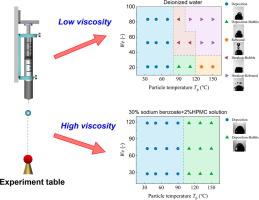Chemical Engineering Science ( IF 4.1 ) Pub Date : 2022-08-04 , DOI: 10.1016/j.ces.2022.117968 Lili Shao , Daoyin Liu , Jiliang Ma , Xiaoping Chen

|
Understanding droplet-particle collisions is critical for regulating spray coating processes. Existing studies mainly focused on collision between a single component droplet and a particle either at room temperature or considerably higher than the boiling point. In this study, we perform experiments of a droplet impacting a heated particle with its temperature in the range of 35 °C–150 °C, where the droplet is generated from multi-component solutions with its viscosity adjusted by adding Hydroxypropyl methyl cellulose (HPMC). The collisions with droplets from 30% sodium benzoate solution show four regimes: deposition, deposition-bubble, breakup-rebound, and rebound. By increasing viscosity with adding 1% or 2% HPMC, only two regimes are observed: deposition and deposition-bubble. The variation of film thickness with time can be divided into three phases. The film thickness in phase I and II can be fitted by simple functions. With increasing liquid viscosity, the film thickness in phase III at different temperatures becomes consistent.
中文翻译:

液体粘度对多组分液滴与加热粒子碰撞影响的实验表征
了解液滴粒子碰撞对于调节喷涂工艺至关重要。现有研究主要集中在室温或远高于沸点的单组分液滴与颗粒之间的碰撞。在这项研究中,我们进行了液滴撞击加热颗粒的实验,其温度范围为 35°C-150°C,其中液滴由多组分溶液产生,其粘度通过添加羟丙基甲基纤维素(HPMC )。与来自 30% 苯甲酸钠溶液的液滴的碰撞表现出四种状态:沉积、沉积-气泡、破裂-回弹和回弹。通过 增加 添加 1% 或 2% HPMC 的粘度,仅观察到两种状态:沉积和沉积气泡。薄膜厚度随时间的变化可分为三个阶段。阶段 I 和阶段 II 的膜厚可以通过简单的函数来拟合。随着液体粘度的增加,不同温度下第三相的膜厚变得一致。











































 京公网安备 11010802027423号
京公网安备 11010802027423号